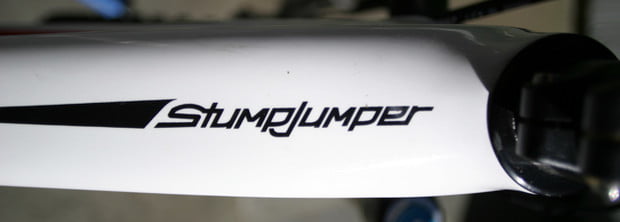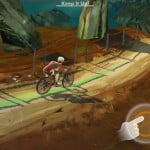It is true wide tires mitigate a good amount of rear-wheel slip, trail chatter and small bump feedback – which benefits beginning riders. But plus bikes can be fun for all. A lot of fun. They can be aggressive and built for any ability. Earlier this season I reviewed an incredibly fast, capable plus-tire trail bike.
As with most things evolutionary, the Specialized Stumpjumper FSR Comp Carbon 6-Fattie (hereinafter known as ‘the bike’ or ‘SSFSRCC6F’) doesn’t address every shortcoming as much as it enables riding in a few nice ways. Newer-ish riders can get on this plus bike and feel very comfortable. You can climb and spin along rough trail more easily, and you can roll over stuff very well. But, for advanced riders, SJFSRCC6F requires some key modifications before it can realize its full potential – and not be dangerous.
In my humble opinion, while it’s nice to make bikes good for newer riders, there’s no reason to limit their top end just for accessibility.
BIKE SPECS:
34mm stanchion 150mm travel Fox float performance fork
135mm travel Fox float shock
Specialized Command Post seatpost
SRAM GX1 1X11 drivetrain with a 28-tooth chainring and 10-42 cassette
X-Horizon GX derailleur
27.5” x 3.0″ Specialized plus tires (Purgatory front and Ground Control rear)
Roval 29mm internal width rims
Boost 148mm rear/110mm front hubs
SWAT internal down-tube storage.
Shimano Deore brakes with 203mm front rotor (respect!)
The “Comp” model I received retails for around $4,500 and sports a carbon front triangle with an aluminum rear. For the price it seems like a pretty nice component mix. There are two models above the Comp – the S-works for $8,600 and Expert for $6,500.

It’s a relatively understated and handsome bike; black, red and white – no extreme colorway. The tubing and BB are very wide, giving it a good, stout feeling.
SETUP:

You must pay really careful attention to tire and suspension pressures on plus bikes, especially dual-suspension models, because the two dynamically affect each other. Of course, any bike requiring an well-honed affinity for suspension tuning counters ‘beginner friendly’ market positioning but… there it is. I got no real beef getting to know a bike’s specific needs.
For some reason my fork came without an ‘O’ ring to help me set sag, but an accompanying guide for the fork suggests air pressure and rebound damping for your weight and riding style – so I started with the recommended 85psi.

I do like the autosag feature on the bike’s custom Fox float shock. Just pump it 50psi greater than your bodyweight, sit on the bike, hit the red release valve and voila – enough air is automatically let out to perfectly set the sag.

But should the 15mm of sag from plus tires be factored in?
Fat/plus bikes ought to ship with a small digital tire gauge. I bought one a few months ago and now I can’t live without it (found out my floor pump is 8psi off – in New England we get pretty specific with inflation pressure). I started with the recommended 15-16 psi in the tires (and ended up needing a bit more).
The bike has 3” tires mounted on 29mm internal-width rims, which give them a round profile and mushroom-like cross-section. As with most bikes, the rear tire sports lower knobs but, at this width, everything grabs.
 The Ground Control rear tire has lower profile knobs than the Purgatory front. GW photo
The Ground Control rear tire has lower profile knobs than the Purgatory front. GW photo
The sidewall on the Specialized tires is also very tall. Marketing copy for the bike states the tire’s height gives the wheel the same rollover radius as a normal 29er.

At any inflation PSI, you can grab a fistful of tire and wiggle it around.
The bike uses asymmetrical suspension (135mm rear and 150mm front) to achieve a 67-degree head angle. In general I’m not a huge fan of this, I think bikes should be level. Some riders throw a slightly longer fork on a bike that could use a slacker head angle (like 2015’s Santa Cruz 5010) and this usually results in the manufacturer slacking out the head tube in following years (like 2016’s Santa Cruz 5010). But I don’t think bikes should be designed with a fork 15 or more mm longer than its rear travel. That’s just me.
Again, you really need to take some time and get the tire pressure/shock pressure settings dialed in over the course of a few rides. After a while I discovered it’s best to run the front tire firmer than the rear by a pound or two. I also wound up with the fork just a hair over recommended pressure, for me around 90psi.
THE RIDE

First few miles felt wonderful. Great climbing, and nice straight-line descending. Out of the box, I thought the 28-tooth front chainring would be an affront to my manhood; I can usually push a bigger gear than that – especially on a 27.5 bike.

But the bike is heavy and that gear ends up being the right choice. Handlebars are nice and wide and the saddle is comfy.
One thing plus bikes do, because they ride so smooth, is keep you pedaling for longer periods of time without stepping off. So rides become more steady-state cardio rather than fast accelerations and stops. I’m a fan of this.

The SSFSRCC6F is great for wearing headphones and just having a fun time for a couple hours with your favorite tunes cranking. You’re going to get over trail features more easily and you’ll be in the saddle for longer stretches. One of my buddies who I loaned the bike to for a short spin commented how easy it was to get the front wheel up and over larger obstacles.

I’ve found myself packing sandwiches and plotting longer rides with lunch breaks on this bike because it’s just nice to stay on and keep spinning. What’s normally a mid-knarly ride kind of becomes a tour. I know nothing about bikepacking, but I assume this bike would work well (though, again, this ‘Comp’ build is a bit heavy).
I’m a HUGE fan of the SWAT internal storage. This is a game-changer. I’ve got a tube in there, some CO2, a multi-tool, quicklinks, zip-ties etc. Coupled with the water-bottle cage, you seldom need to wear a pack for short or medium rides.

The dropper post is excellent. It’s not infinite, there’s a top, a bottom and a few in-between notches, but it’s reliable and doesn’t feel limited in any way.

Especially nice is the ergonomic trigger – very intuitive.
As with most plus bikes, traction while climbing is great, but because this bike is burly (especially with a bunch of junk jammed in the down-tube), it’s not quite as effortless as the Trek Stache. It has a very long wheelbase, despite de rigueur shorter chainstays, which makes it stable while cruising along.

In terms of compression damping, you must pay attention and adjust it during a ride. Some bikes it’s not that big a deal but, on this bike, platform settings make a big difference. Thankfully, the shock and fork levers are pretty easy to reach on the fly.
Firming up both shock and fork for climbing (the ‘firm’ or ‘climb’ mode) gets you up stuff really well. They aren’t true lockouts, so the suspension stays active over climbing bumps without wallowing.

For average trail riding, setting both fork and shock in ‘trail’ or ‘medium’ mode is best. But, for descending, I feel you do NOT want the fork in ‘descend’ or ‘open’ mode. Between the weight of the bike, the grip in the tires and a few other factors, the fork goes through it’s travel very quickly and changes the bike’s head angle – altering the bike’s steering characteristics and pulling your weight forward.

So the bike actually descends best with the shock’s compression damping off (‘descend’ or ‘open’ mode) and the fork in the ‘trail’ or ‘medium’ setting.
For straight-line descending, especially at slower or just-rolling-along speeds, it’s a capable bike that can get you over some decent features. The wheels ramble over stuff well and the plus-tire grip means you’re always in solid control. Until you’re not.
THE PROBLEMS COME WHEN YOU TRY TO RIDE IT VERY AGGRESSIVELY.
This bike has a few issues that might border on dangerous. I’m not sure if some things outlined below are addressed at the bike’s higher-end build levels by rim width, weight or tuning, so keep in mind I’m talking about the Comp model. Also, I’m not an engineer, so this is based mostly on my judgement and experience as someone who’s ridden a lot of different bikes.
 My buddy Rip, JRA. GW photo
My buddy Rip, JRA. GW photo
As you ride along, the longer front travel than rear means the bike’s fork goes through more travel (in length, not percentage) than the shock in any given situation – especially descending. Thus, the head angle gets steeper as you blow through the bike’s suspension. Though this certainly isn’t unique to the 6fattie, the tires’ traction and bike’s weight might compound the issue.
Also, plus tires brake different. The wide contact patch provides a wonderful amount of traction – great for climbing – but, obviously, increased traction also means greater, more immediate, braking forces transferring to the suspension. Of course having good, stout braking is not a bad thing either.

Despite its solid and immediate stopping power, when descending, the increased braking forces compress the fork at a sharper rate than a regular tire would as you squeeze the levers. Again, decreasing the head angle and changing the bike’s handling quicker than normal. This could be mitigated by Specialized evening out travel between fork and shock or perhaps a custom tune.
Most importantly, I feel the tires are WAY TOO FAT for the rim. Way too fat. I’ve read a few other reviews on this bike calling out the odd decision to mount 3” tires on a narrow rim, but they moved on without too much analysis. I’m going farther: This needs to be changed for the coming model years. At speed cornering or in technical situations it’s unstable and dangerous.

When descending hard and braking on rough terrain, right before going into a berm or corner with some off-angle technical feature, a pretty sketchy chain of events can get set in motion; tires grab, fork compresses at a greater rate than rear shock, head angle changes, cornering forces and a taller tire sidewall coupled with lower tire pressure (compounded by this bike’s very narrow rims) cause the tires to squirm laterally and either roll off the wheel or snap the fork into an undesirable angle.

The G-forces of a turn or an off-camber strike can leverage a tire’s (especially a tubeless one with a tall, soft sidewall) contact patch to move outside the width of the rim flanges. This is almost inevitable with a high-volume plus tire on a narrow rim. Any tire’s ability to support the rider at this moment is significantly reduced and can result in the tire suddenly collapsing under the weight of the rider – either misdirecting the fork or losing pressure. If you want to read more, there’s a really good article about it here.
If you’re hitting a jump with speed and pump into the transition for height, that also might over-stress the tire and twerk it sideways.
The first time or two this happened to me I thought it was an anomaly and adjusted the fork and/or tire tune. Unfortunately, even at what I thought were optimum settings, this flaw was re-creatable. On the gas, approaching 20mph or greater, with quick ramp up of pressure into the wheel (either from a berm, an off-camber trail feature or a fast transition), the rider gets flicked sideways when the tire fails from ramping up lateral forces into the wheel – with the final time ending me up with a broken scapula (just like Dan Atherton!). The things I do for you people.
To be fair, I called the guys at Specialized and they were very concerned and wanted to know all about the conditions and specific times this happened. I spoke to the product manager for the bike and he assured me the bike had been ridden in a variety of conditions, and they had even developed a 38mm internal-width rim, but had decided not to use it because they didn’t feel it had a huge benefit. They also felt that at 182lbs, I should be running the tires slightly closer to 20 psi than 16 or 17 psi.
I get a little OCD about tire pressure, and had tested the bike with everything from 14 to 20psi. I asked if there was a chart or guide I could publish and they said “Tire pressure always has to take into account 4 basic factors: rider weight, riding style (are you an aggressive, or mellow rider), terrain, and tire casing. While tire casing and body weight are pretty definitive, riding style and terrain are pretty subjectively judged.”
THE TAKEAWAY
This is a good bike. But a bike that can be made better with adjustments. As it is, it’s fun for riding on a trail in a manner slightly more aggressively than a traditional fatbike. It’s great for cruising long distances and it can handle a lot of very decent, and even challenging, trail riding. But because of that sketchy ceiling, I’m reluctant to recommend it for pushing super hard. However, I don’t think plus bikes need to have that sort of limitation – they can be as rad as anything else.

Specialized’s 29mm rim needs to be changed. Scott’s plus bikes use an 40mm internal width rim with a 2.8” tire and Trek specs a 50mm internal width rim for it’s 3.0” tire. The rim on the 6fattie should be at least 40mm internal. And forgo the ‘same rollover as a 29er’ marketing copy for the stability of a shorter, stiffer sidewall.
As is, the rims on this bike would be perfect for throwing on a set of 2.4” tires. And maybe this was part of the thinking, use 3” tires for cruising and throw a narrower set on to create an instant trail ripper. Specialized’s marketing line about using a narrow rim for weight doesn’t quite pass the smell test.
And they should even out the suspension. Ship this bike with 135mm front and rear, and slacken the head tube to get the head angle back to 67 degrees (or fewer) without asymmetrical suspension.

There’s another big question that hangs over most bike reviews: Does this bike justify the purchase of another bike – or is it right as someone’s first, or only, bike. No for the former, it doesn’t fill a burning whitespace as much as it evolves the capability of its category. A qualified yes for the latter, it will be great if you get on this as your first bike – and you won’t push the limits on it for several years – and again, there’s a nice fun zen to riding it in most scenarios.
[“source-tetongravity”]







